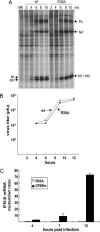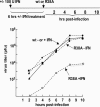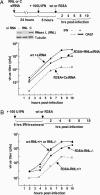The primary function of RNA binding by the influenza A virus NS1 protein in infected cells: Inhibiting the 2'-5' oligo (A) synthetase/RNase L pathway
- PMID: 16627618
- PMCID: PMC1459024
- DOI: 10.1073/pnas.0602184103
The primary function of RNA binding by the influenza A virus NS1 protein in infected cells: Inhibiting the 2'-5' oligo (A) synthetase/RNase L pathway
Abstract
The NS1 protein of influenza A virus (NS1A protein) is a multifunctional protein that counters cellular antiviral activities and is a virulence factor. Its N-terminal RNA-binding domain binds dsRNA. The only amino acid absolutely required for dsRNA binding is the R at position 38. To identify the role of this dsRNA-binding activity during influenza A virus infection, we generated a recombinant influenza A/Udorn/72 virus expressing an NS1A protein containing an RNA-binding domain in which R38 is mutated to A. This R38A mutant virus is highly attenuated, and the mutant NS1A protein, like the WT protein, is localized in the nucleus. Using the R38A mutant virus, we establish that dsRNA binding by the NS1A protein does not inhibit production of IFN-beta mRNA. Rather, we demonstrate that the primary role of this dsRNA-binding activity is to protect the virus against the antiviral state induced by IFN-beta. Pretreatment of A549 cells with IFN-beta for 6 h did not inhibit replication of WT Udorn virus, whereas replication of R38A mutant virus was inhibited 1,000-fold. Using both RNA interference in A549 cells and mouse knockout cells, we show that this enhanced sensitivity to IFN-beta-induced antiviral activity is due predominantly to the activation of RNase L. Because activation of RNase L is totally dependent on dsRNA activation of 2'-5' oligo (A) synthetase (OAS), it is likely that the primary role of dsRNA binding by the NS1A protein in virus-infected cells is to sequester dsRNA away from 2'-5' OAS.
Conflict of interest statement
Conflict of interest statement: No conflicts declared.
Figures





References
-
- Wright P. F., Webster R. G. In: Fields Virology. 4th Ed. Knipe D. M., Howley P. M., editors. Philadelphia: Lippincott Williams & Wilkins; 2001. pp. 1533–1579.
-
- Reid A. H., Taubenberger J. K., Fanning T. G. Microbes Infect. 2001;3:81–87. - PubMed
-
- Horimoto T., Kawaoka Y. Nat. Rev. Microbiol. 2005;3:591–600. - PubMed
-
- Noah D. L., Krug R. M. In: Advances in Virus Research. Maramorsch K., Shatkin A. J., editors. Vol. 65. Amsterdam: Elsevier; 2005. pp. 121–145. - PubMed
-
- Garcia-Sastre A. Virology. 2001;279:375–384. - PubMed
Publication types
MeSH terms
Substances
Grants and funding
LinkOut - more resources
Full Text Sources
Other Literature Sources

